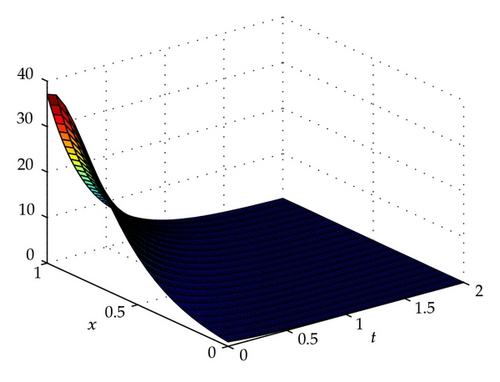Cubic B-Spline Collocation Method for One-Dimensional Heat and Advection-Diffusion Equations
Abstract
Numerical solutions of one-dimensional heat and advection-diffusion equations are obtained by collocation method based on cubic B-spline. Usual finite difference scheme is used for time and space integrations. Cubic B-spline is applied as interpolation function. The stability analysis of the scheme is examined by the Von Neumann approach. The efficiency of the method is illustrated by some test problems. The numerical results are found to be in good agreement with the exact solution.
1. Introduction
Advection-diffusion equation arises very frequently in transferring mass, heat, energy, and vorticity in chemistry and engineering. Thus, it has been of interest to many authors. A third-degree B-spline function has been used by Caglar et al. for solving one-dimensional heat equation with a nonlocal initial condition [1]. Mohebbi and Dehghan [2] have presented a fourth-order compact finite difference approximation and cubic C1-spline collocation method for the solution with fourth-order accuracy in both space and time variables, O(h4, k4). In [3], Dag and Saka concluded that collocation scheme is easy to implement compared to other numerical methods with giving a better result.
In this paper, a combination of finite difference approach and cubic B-spline method would be considered to solve the one-dimensional heat and advection-diffusion equation. Forward finite difference approach would be used for discretizing the derivative of time, while cubic B-spline would be applied to interpolate the solutions at time t. Von Neumann approach would be used to prove the unconditionally stable property of the method. Finally, the approximated solutions and the numerical errors would be presented to demonstrate the efficiency of the method.
2. Collocation Method
| xi | xi+1 | xi+2 | xi+3 | xi+4 | |
|---|---|---|---|---|---|
| Bi | 0 | 0 | |||
| 0 | 0 | 0 | |||
| 0 | 0 |
- (1)
, i = 0,
- (2)
, i = 0,1, …, n,
- (3)
, i = n.
This yields a (n + 3) × (n + 3) matrix system where the solution can be found by Thomas algorithms.
3. Stability Analysis
4. Numerical Results
4.1. Problem 1
4.2. Problem 2
| Grid point | h = 0.02 | h = 0.01 | ||
|---|---|---|---|---|
| C1-spline [2] | Present method | C1-spline [2] | Present method | |
| 0.1 | 7.1744 × 10−6 | 8.2212 × 10−6 | 1.8035 × 10−6 | 2.0556 × 10−6 |
| 0.2 | 1.1019 × 10−5 | 2.2566 × 10−5 | 2.7685 × 10−6 | 5.6432 × 10−6 |
| 0.3 | 1.6596 × 10−5 | 4.5188 × 10−5 | 4.1679 × 10−6 | 1.1298 × 10−5 |
| 0.4 | 2.4579 × 10−5 | 7.7748 × 10−5 | 6.1705 × 10−6 | 1.9435 × 10−5 |
| 0.5 | 3.5871 × 10−5 | 1.2011 × 10−4 | 9.0026 × 10−6 | 3.0020 × 10−5 |
| 0.6 | 5.1637 × 10−5 | 1.6809 × 10−4 | 1.2955 × 10−5 | 4.2001 × 10−5 |
| 0.7 | 7.3208 × 10−5 | 2.1002 × 10−4 | 1.8360 × 10−5 | 5.2464 × 10−5 |
| 0.8 | 1.0163 × 10−4 | 2.2264 × 10−4 | 2.5476 × 10−5 | 5.5602 × 10−5 |
| 0.9 | 1.3624 × 10−4 | 1.6833 × 10−4 | 3.4134 × 10−5 | 4.2039 × 10−5 |

5. Conclusions
A numerical method based on collocation of cubic B-spline had been described in the previous section for solving one-dimensional heat and advection-diffusion equations. A finite difference scheme had been used for discretizing time derivatives and cubic B-spline for interpolating the solutions at each time level. From the test problems, the obtained results show that the presented method is capable for solving one-dimensional heat and advection-diffusion equations accurately with a promised stability.
Acknowledgment
The authors would like to acknowledge with thanks the financial support from Malaysian Government in the form of Fundamental Research Grant Scheme (FRGS) of number 203/PMATHS/6711150.




